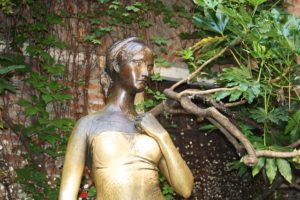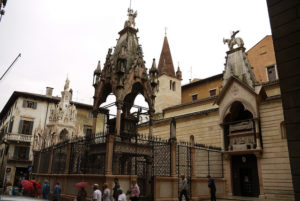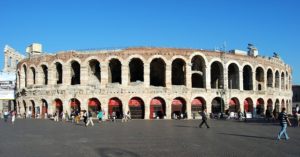
The medieval house, bearing the coat of arms of a hat, home of the Capulet family, has left any couple dreaming of their passionate love story, travelling to Verona![]() , the destination of many lovers who want to relive the magic and power of the troubled love story par excellence of ‘Romeo and Juliet’. With a good dose of imagination, it will seem easy to most to imagine her leaning out of that balcony as her young suitor the Montague lusts after her from below, just as Shakespeare immortalised them in one of the world’s most popular tragedies.
, the destination of many lovers who want to relive the magic and power of the troubled love story par excellence of ‘Romeo and Juliet’. With a good dose of imagination, it will seem easy to most to imagine her leaning out of that balcony as her young suitor the Montague lusts after her from below, just as Shakespeare immortalised them in one of the world’s most popular tragedies.

Precisely in order to avoid the same fate of the two blossoming and ill-fated lovers, many caress the right breast of the statue displayed in the inner atrium of the house-museum![]() , depicting the very young Juliet. A custom that meant that in 2014 the original statue, placed there in 1972 and created by sculptor Nereo Costantini in 1969, was replaced by a copy, as it had been worn down by decades of visitor contact. On the new sculpture, however, the small hole left open right on the breast is a reminder of the ‘traditional good-luck gesture’ celebrated by lovers all over the world.
, depicting the very young Juliet. A custom that meant that in 2014 the original statue, placed there in 1972 and created by sculptor Nereo Costantini in 1969, was replaced by a copy, as it had been worn down by decades of visitor contact. On the new sculpture, however, the small hole left open right on the breast is a reminder of the ‘traditional good-luck gesture’ celebrated by lovers all over the world.

Another custom, perhaps a less pleasant one and one that has been opposed over time, was that of leaving tearful prayers or simple signatures on the walls surrounding the theatre of this ‘love procession’. A pilgrimage that touches on many other destinations, such as the ‘fortified’ house of Romeo![]() , next to the Arche Scaligere
, next to the Arche Scaligere![]() , or the red marble sarcophagus in the former convent of San Francesco al Corso, home of the ‘G.B. Cavalcaselle’
, or the red marble sarcophagus in the former convent of San Francesco al Corso, home of the ‘G.B. Cavalcaselle’ ![]() fresco museumMaps-icon-small and believed to be Juliet’s tomb.
fresco museumMaps-icon-small and believed to be Juliet’s tomb.
In the ‘Urbs Marmorea’, in the ‘City of Marble’ as it was called in the Middle Ages, given the extensive use of stone in street furniture, although ‘Romeo and Juliet’ consecrates it to worldwide attention, it certainly does not lack other strengths.

The ‘Arena’![]() , for example, the Roman amphitheatre in the heart of the city’s historic centre, is one of the best-preserved and best-known Roman amphitheatre architectures.
, for example, the Roman amphitheatre in the heart of the city’s historic centre, is one of the best-preserved and best-known Roman amphitheatre architectures.
degree of preservation and best known in the world along with the Colosseum in Rome (Lazio) and the amphitheatre in Santa Maria Capua Vetere (Caserta – Campania). The fascinating venue, one hundred and ten metres wide and one hundred and forty metres long, with a sequesnza formed by seventy-two double stone arches, is the proscenium of many international events: from the ‘Festival lirico areniano’, held every summer since 1913, to the finals of the popular ‘Festivalbar’, as well as a final of the ‘Giochi senza frontiere’ (games without frontiers) and the final stages of two editions of the ‘Giro d’Italia’. The amphitheatre also hosts important concerts of national and international pop music.
